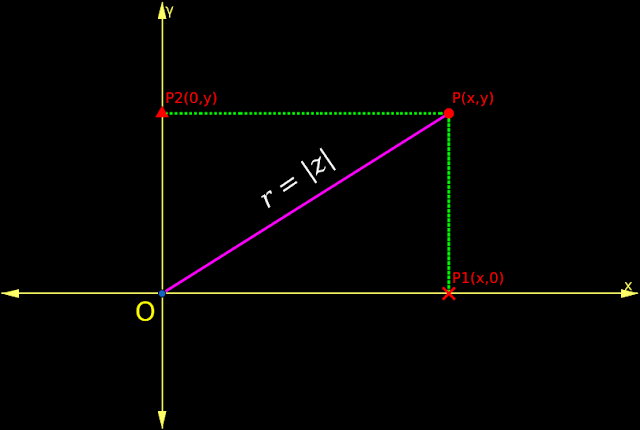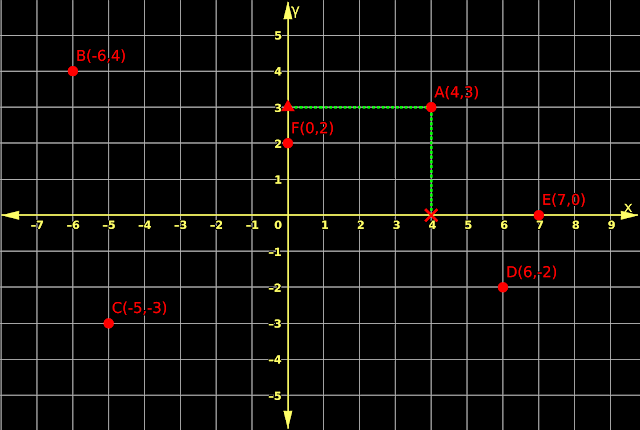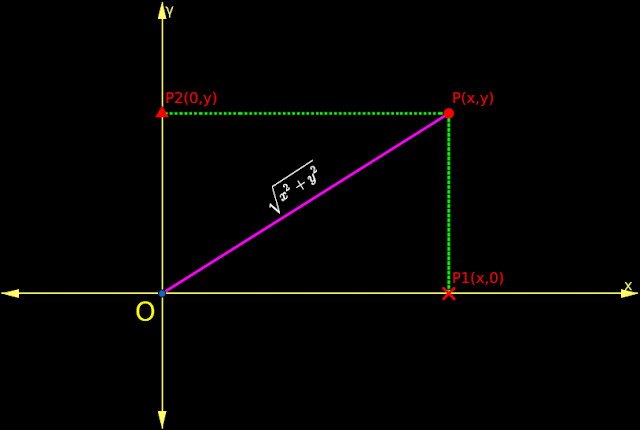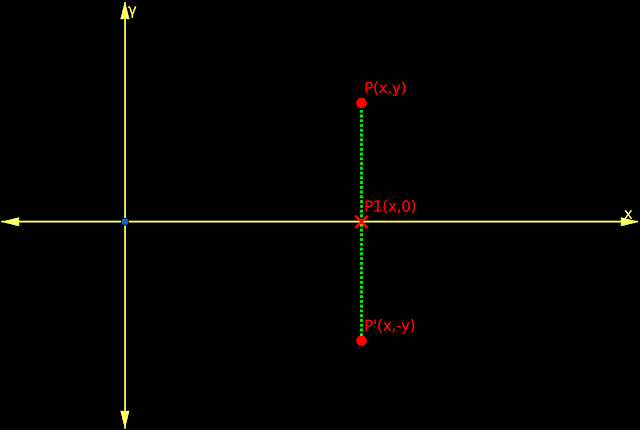In the previous section, we completed a discussion on polar representation. In this section, we will see quadratic equation.
Some basics can be written in 6 steps:
1. Consider the general form of quadratic equations: $ax^2+bx+c=0$
We know that the solutions of this type of equations are given by:
$x=\frac{-b \pm \sqrt{b^2 - 4ac}}{2a}$
2. We see that, square root of b2-4ac is involved.
• This b2-4ac is called the discriminant of the quadratic equation.
♦ If the discriminant is greater than zero, there will be two real solutions.
♦ If the discriminant is equal to zero, there will be one real solution.
3. In some cases, b2-4ac
may be less than zero. We know how to proceed in such cases. We saw it in section 5.1 of this chapter.
Now we will see some solved examples:
Solved Example 5.8
Solve $x^2+2=0$
Solution:
1. The given equation can be written as: $x^2=-2$
2. Taking square roots on both sides, we get:
$x=\pm \sqrt{-2}$
3. So we can write:
The solutions are: $x=\sqrt{-2}~~ \text{and}~~-\sqrt{-2}$
4. But $\sqrt{-2}$ is $\sqrt{2}\,i$
• So we get:
The solutions are: $x=\sqrt{2}\,i~~ \text{and}~~-\sqrt{2}\,i$
Solved Example 5.9
Solve $x^2+x+1=0$
Solution:
1. From the given equation, we get: a = 1, b= 1 and c = 1
• So the discriminant of the given equation is:
$b^2-4ac~=~(1)^2 -4 × 1 × 1~=~1-4~=~-3$
2. We can write:
$x=\frac{-b \pm \sqrt{b^2 - 4ac}}{2a}~=~\frac{-1 \pm \sqrt{-3}}{2 × 1}~=~\frac{-1 \pm \sqrt{3}\,i}{2}$
3. So the solutions are:
$x~=~\frac{-1 + \sqrt{3}\,i}{2}~~ \text{and}~~\frac{-1 - \sqrt{3}\,i}{2}$
Check:
◼ First we will put $\frac{-1 + \sqrt{3}\,i}{2}$ in the place of x:
$\begin{array}{ll}
x^2&{}={}&\left(\frac{-1 + \sqrt{3}\,i}{2} \right)^2& {} &{} \\
\phantom{x^2}&{}={}& \left(\frac{-1}{2} + \frac{\sqrt{3}\,i}{2} \right)^2&{} \\
\phantom{x^2}&{}={}& \left(\frac{-1}{2}\right)^2~ +~2 ×
\frac{-1}{2} × \frac{\sqrt{3}\,i}{2}~+~\left(\frac{\sqrt{3}\,i}{2}
\right)^2&{} \\
\phantom{x^2}&{}={}& \frac{1}{4}~ -~\frac{\sqrt{3}\,i}{2}~-~\frac{3}{4}&{} \\
\phantom{x^2}&{}={}& -\frac{1}{2}~ -~\frac{\sqrt{3}\,i}{2}&{} \\
\end{array}$
• Thus we get:
$\begin{array}{ll}
x^2+x+1&{}={}&-\frac{1}{2}~ -~\frac{\sqrt{3}\,i}{2}~+~\frac{-1}{2} + \frac{\sqrt{3}\,i}{2}~+~1& {} &{} \\
\phantom{x^2+x+1}&{}={}& -\frac{1}{2}~-~\frac{1}{2}~+~1&{} \\
\phantom{x^2+x+1}&{}={}& -1~+~1&{} \\
\phantom{x^2+x+1}&{}={}&0&{} \\
\end{array}$
• So $\frac{-1 + \sqrt{3}\,i}{2}$ is indeed a solution.
• In the same way we can check $\frac{-1 - \sqrt{3}\,i}{2}$ also.
◼ We can write:
♦ If the discriminant is less than zero, there will be two imaginary solutions.
Solved Example 5.10
Solve $\sqrt{5}x^2+x+\sqrt{5}=0$
Solution:
1. From the given equation, we get: a = $\sqrt{5}$, b= 1 and c = $\sqrt{5}$
• So the discriminant of the given equation is:
$b^2-4ac~=~(1)^2 -4 × \sqrt{5} × \sqrt{5}~=~1-4 × 5~=~1-20~=~-19$
2. We can write:
$x=\frac{-b \pm \sqrt{b^2 - 4ac}}{2a}~=~\frac{-1 \pm \sqrt{-19}}{2 × \sqrt{5}}~=~\frac{-1 \pm \sqrt{19}\,i}{2 \sqrt{5}}$
3. So the solutions are:
$x~=~\frac{-1 + \sqrt{19}\,i}{2 \sqrt{5}}~~ \text{and}~~\frac{-1 - \sqrt{19}\,i}{2 \sqrt{5}}$
The link below gives a PDF file with more solved examples:
Now we will see some miscellaneous examples from the topics that we saw in this chapter.
Solved example 5.11
Find the conjugate of $\frac{(3-2i)(2+3i)}{(1+2i)(2-i)}$
Solution:
1. First we will simplify the numerator:
$\begin{array}{ll}
(3-2i)(2+3i)&{}={}&6+9i-4i-6i^2& {} &{} \\
\phantom{(3-2i)(2+3i)}&{}={}&6+5i+6&{} \\
\phantom{(3-2i)(2+3i)}&{}={}&12+5i&{} \\
\end{array}$
2. Next we will simplify the denominator:
$\begin{array}{ll}
(1+2i)(2-i)&{}={}&2-i+4i-2i^2& {} &{} \\
\phantom{(1+2i)(2-i)}&{}={}&2+3i+2&{} \\
\phantom{(1+2i)(2-i)}&{}={}&4+3i&{} \\
\end{array}$
3. Now the given expression become: $\frac{12+5i}{4+3i}$
4. This can be written in the form x+yi:
$\begin{array}{ll}
\frac{12+5i}{4+3i}&{}={}&\frac{12+5i}{4+3i} × \frac{4-3i}{4-3i}& {} &{} \\
\phantom{\frac{12+5i}{4+3i}}&{}={}&\frac{48-36i+20i-15i^2}{16-9i^2}&{} \\
\phantom{\frac{12+5i}{4+3i}}&{}={}&\frac{48-16i+15}{16+9}&{} \\
\phantom{\frac{12+5i}{4+3i}}&{}={}&\frac{63-16i}{25}&{} \\
\phantom{\frac{12+5i}{4+3i}}&{}={}&\frac{63}{25}-\frac{16i}{25}&{} \\
\end{array}$
5. Now the conjugate can be written as: $\frac{63}{25}+\frac{16i}{25}$
Solved example 5.12
Find the modulus and argument of the complex numbers:
(i) $\frac{1+i}{1-i}$ (ii) $\frac{1}{1+i}$
Solution:
Part (i):
1. The given expression can be written in the form x+yi':
$\begin{array}{ll}
\frac{1+i}{1-i}&{}={}&\frac{1+i}{1-i} × \frac{1+i}{1+i}& {} &{} \\
\phantom{\frac{1+i}{1-i}}&{}={}&\frac{1+2i+i^2}{1-i^2}&{} \\
\phantom{\frac{1+i}{1-i}}&{}={}&\frac{1+2i-1}{1+1}&{} \\
\phantom{\frac{1+i}{1-i}}&{}={}&\frac{1+2i-1}{1+1}&{} \\
\phantom{\frac{1+i}{1-i}}&{}={}&\frac{2i}{2}&{} \\
\phantom{\frac{1+i}{1-i}}&{}={}&i&{} \\
\phantom{\frac{1+i}{1-i}}&{}={}&0+i&{} \\
\end{array}$
2. The complex number does not have a real part. So it lies on the y axis.
• Since the coefficient of i is '+1', the complex number lies on the +ve side of the y axis.
• Since it lies on the +ve side of the y axis, the argument $\theta=\frac{\pi}{2}$
3. Since the coefficient of i is '1', the complex number lies at a distance of at a distance of 1 unit from the origin. So modulus r = 1
• This is shown in fig.5.8(a) below:
 |
| Fig.5.8 |
Part(ii):
1. The given expression can be written in the form x+yi':
$\begin{array}{ll}
\frac{1}{1+i}&{}={}&\frac{1}{1+i} × \frac{1-i}{1-i}& {} &{} \\
\phantom{\frac{1}{1+i}}&{}={}&\frac{1-i}{1-i^2}&{} \\
\phantom{\frac{1}{1+i}}&{}={}&\frac{1-i}{1+1}&{} \\
\phantom{\frac{1}{1+i}}&{}={}&\frac{1-i}{2}&{} \\
\phantom{\frac{1}{1+i}}&{}={}&\frac{1}{2}\,-\,\left(\frac{1}{2} \right)i&{} \\
\end{array}$
2. Now the complex number is in the form x+yi. If we can find the modulus (r) and argument (𝜽), we can write it in the polar form:
r[cos 𝜽 + i sin 𝜽]
3. Since the two forms are equal, we can equate the corresponding parts:
♦ Equating the real parts, we get: x = r cos 𝜽
♦ Equating the imaginary parts, we get: y = r sin 𝜽
4. We know that $r=|z|=\sqrt{x^2+y^2}$
• So in our present case, we get:
$r=\sqrt{\left(\frac{1}{2} \right)^2+\left(\frac{1}{2} \right)^2}=\sqrt{\frac{1}{4}+\frac{1}{4}}=\sqrt{\frac{1}{2}}=\pm \frac{1}{\sqrt{2}}$
• r is the distance between the complex number and the origin. A distance cannot be -ve. So we can write: $r=
\frac{1}{\sqrt{2}}$
5. From the results in (3), we get:
(i) $x=\frac{1}{2}=\frac{1}{\sqrt{2}} \cos \theta$
(ii) $y=-\frac{1}{2}=\frac{1}{\sqrt{2}} \sin \theta$
• cos 𝜽 is +ve and sin 𝜽 is -ve. So it lies in the fourth quadrant.
6. Taking ratios, (ii) to (i), we get:
$\frac{\frac{1}{\sqrt{2}} \sin \theta}{\frac{1}{\sqrt{2}} \cos \theta}=\frac{-\frac{1}{2}}{\frac{1}{2}}$
$\Rightarrow \tan \theta = -1$
• This is a trigonometrical equation. We learned to solve them in chapter 3. (Details here)
7. We know that, $\tan \frac{\pi}{4}=1$
• We have the identity: tan (π-𝜽) = -tan 𝜽
If we put $\theta = \frac{\pi}{4}$, we get:
$\tan \left(\pi - \frac{\pi}{4} \right)=-\tan \frac{3\pi}{4} = -1$
$\Rightarrow \tan \left(\frac{3\pi}{4} \right)=-tan \frac{\pi}{4} = -1$
$\Rightarrow \tan \theta = \tan \left(\frac{3\pi}{4} \right) = -1$
• From this we get: $\theta = \frac{3\pi}{4}$
• This value of 𝜽 lies in the second quadrant. So it is not acceptable.
8. There is another possible value for 𝜽. It can be calculated using the identity: tan 𝜽 = tan (π+𝜽)
• So we can write:
$\tan \frac{3\pi}{4}=\tan \theta = \tan \left(\pi + \theta \right)= \tan \left(\pi + \frac{3\pi}{4}\right) = -1$
• From this we get: $\tan \theta = \tan \left( \frac{7\pi}{4}\right) = -1$
• So $\theta = \frac{7\pi}{4}$
• This value of 𝜽 lies in the fourth quadrant. So it is acceptable.
9. Thus we get the values of r and 𝜽:
♦ From (4), we get: $r=
\frac{1}{\sqrt{2}}$
♦ From (7),we get: $\theta = \frac{7\pi}{4}$
10. $\theta = \frac{7\pi}{4}$ indicates that, the complex number is in the fourth quadrant. When a complex number is in the fourth quadrant, we assume the angle of rotation to be clockwise.
• Thus we get: $2\pi-\frac{7\pi}{4}~=~-\frac{\pi}{4}$
• So angle of rotation is $-\frac{\pi}{4}$
11. So the required values are:
♦ From (4), we get: $r=
\frac{1}{\sqrt{2}}$
♦ From (9),we get: $\theta = -\frac{\pi}{4}$
• This is shown in fig.5.8(b) above.
In the next section, we will see a few more miscellaneous examples.
Copyright©2022 Higher secondary mathematics.blogspot.com





